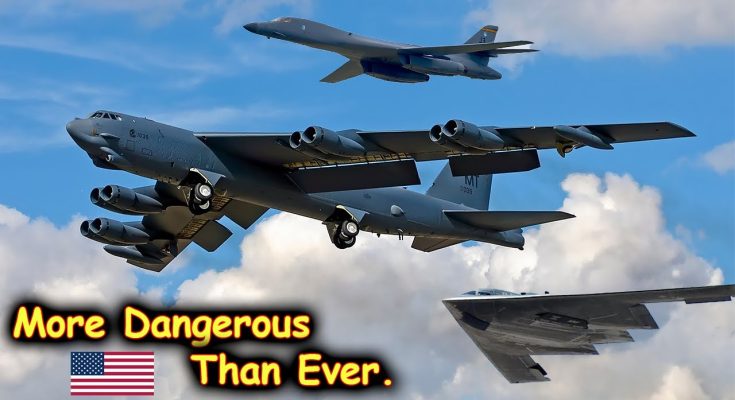U.S. Implements New Upgrades for the Trio of DEVASTATING BOMBERS – SHOCKING the World!
In a bold move that has left military analysts and defense experts stunned, the United States has announced a series of groundbreaking upgrades to its trio of strategic bombers, effectively enhancing the firepower and capabilities of its long-range strike force. These bombers—the B-52 Stratofortress, B-1B Lancer, and B-2 Spirit—have long been key pillars of U.S. airpower, and with these new enhancements, they are set to remain formidable threats on the global stage for decades to come. This move signals a new era in bomber operations, showcasing the U.S. commitment to maintaining its dominance in long-range strategic bombing capabilities.
B-52 Stratofortress: The Veteran Gets a New Lease on Life
The B-52 Stratofortress, originally designed in the 1950s, has been a stalwart of the U.S. Air Force for over 60 years. Despite its age, the B-52 remains one of the most capable bombers in the world, thanks to constant upgrades. The latest series of improvements focus on its avionics, weapons systems, and engine reliability.
One of the most significant upgrades is the installation of the Combat Network Communications Technology (CONECT) system, allowing the B-52 to seamlessly integrate into modern, networked combat environments. This system enables the bomber to communicate with other aircraft, satellites, and ground forces, providing a higher level of situational awareness. Additionally, the B-52 is receiving an overhaul of its engine components, including a replacement for its aging TF33 engines with more fuel-efficient, modernized engines, drastically extending its service life. These upgrades ensure that the B-52 remains a potent tool for nuclear deterrence and conventional bombing missions well into the 2040s.
B-1B Lancer: Enhanced Precision Strikes
The B-1B Lancer has always been known for its speed and versatility, capable of carrying a heavy payload of conventional munitions. The latest upgrades to the B-1B focus on improving its ability to conduct precision strikes and operate in highly contested environments. A key enhancement is the integration of a new radar system that boosts the bomber’s ability to detect and engage targets while reducing its vulnerability to enemy defenses.
Furthermore, the B-1B is being equipped with the Advanced Munitions Data Link (AMDL), which allows for the deployment of smarter, more accurate weapons, including precision-guided bombs and hypersonic weapons. This allows the Lancer to strike targets with pinpoint accuracy, even in heavily defended airspaces. The B-1B also benefits from updated cockpit avionics, providing better communication and coordination with joint and allied forces during operations.
These upgrades enhance the B-1B’s role in delivering devastating conventional strikes on time-sensitive targets and ensure that it remains a valuable asset in modern warfare.
B-2 Spirit: Stealth Meets Superiority
The B-2 Spirit is arguably the most advanced bomber in the U.S. arsenal, primarily known for its stealth capabilities that allow it to penetrate the most heavily defended airspaces. The recent upgrades to the B-2 focus on further enhancing its stealth and survivability, especially in future conflicts with advanced air defense systems.
Key upgrades include improved low-observable technologies to make the B-2 even harder to detect by enemy radar. Additionally, the B-2 is receiving software and hardware modifications to integrate the latest precision-guided munitions, including the highly anticipated hypersonic weapons. These weapons, capable of traveling at speeds greater than Mach 5, will give the B-2 unprecedented strike capabilities against high-value targets, such as enemy command centers or missile sites.
Another major upgrade is the addition of more modern cockpit avionics to allow the crew to operate in increasingly complex and contested environments. The B-2’s stealth will enable it to bypass even the most sophisticated radar systems, and the new enhancements will ensure it can strike with near-complete impunity, making it a true force multiplier in the U.S. strategic bombing capability.
A Unified Force for the Future
The new upgrades to the B-52, B-1B, and B-2 bombers collectively ensure that the U.S. maintains a powerful and versatile bomber fleet for the future. While each bomber serves a unique role—strategic deterrence, conventional strikes, and deep-penetration missions—they are now more interconnected than ever. These bombers can operate in harmony, with their enhanced communication systems and upgraded targeting technologies, making them a formidable trio capable of responding to a wide variety of global threats.
These upgrades also signify the U.S. Air Force’s recognition of the growing importance of long-range strike capabilities in modern warfare. As the world faces increasingly complex geopolitical tensions and technological advancements, the ability to project power anywhere in the world—whether with conventional or nuclear weapons—remains a critical element of American military strategy.
Conclusion: A Game-Changer in Global Defense
The recent upgrades to the B-52, B-1B, and B-2 bombers are a game-changer in global defense strategy. The U.S. Air Force has ensured that these bombers will remain potent tools of power projection, deterrence, and combat effectiveness for many years to come. These upgrades not only bolster the United States’ ability to respond to threats but also send a powerful message to adversaries: America’s long-range strategic strike capabilities are stronger than ever. With advanced avionics, new weapons systems, and an expanded role for hypersonic technology, the U.S. bomber fleet is set to remain a dominant force in global defense for the foreseeable future.



